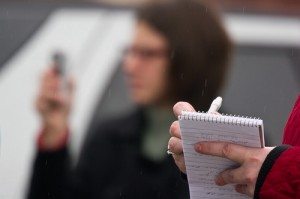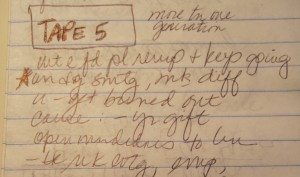
“Leave the notebook at home.” That’s what one journalism site recommended when reviewing Evernote, a digital service that stores notes, pictures and Web clips online so users can access them anywhere from any device. It’s a cool tool but it hasn’t replaced my reporter’s notebook and I don’t think it ever will.
A pad and pen are still the most convenient way I’ve found to take notes on assignment. They’re super portable, reliable in all kinds of conditions and never need recharging.
I’ve worked in broadcast news almost my entire career, so I’ve always recorded interviews for radio or television. But as photojournalist Rich Murphy says, “A camera is not a notebook” and shouldn’t be used like one. People who rely on digital recorders instead of taking notes have to go back and listen to everything again to find the sound bites or quotes they’ll use in a story. That’s a huge time suck, and in every newsroom I’ve worked in there’s simply no time to waste.
So how do you take good notes? Like most people, I learned to take notes in school but soon discovered that what worked for me in class didn’t fit my needs as a reporter. As a student, I wrote down pretty much everything the professor said and reviewed my notes later to figure out what was important. As a journalist, I learned to listen for what was most important in an interview and just write that part down. Actually, it’s probably more accurate to say that I learned to distinguish what was NOT important and left that part out.
 These notes are from an interview I did in 2009. Can I still read them? Absolutely. The part I’ve starred reads: “What we found is people recuperate and keep going. When you’re doing something, making a difference, you don’t get burned out.”
These notes are from an interview I did in 2009. Can I still read them? Absolutely. The part I’ve starred reads: “What we found is people recuperate and keep going. When you’re doing something, making a difference, you don’t get burned out.”
I never learned shorthand but I developed my own abbreviations to save time, picking up ideas from colleagues along the way. I use a dash for “not” or a negative, for example, and an underline to signify “ing” at the end of a word. I leave out a lot of letters. Lower case “e” is “we” and “pl” is “people.” Many years before texting became a verb, I was using the same abbreviations in my notes that many people now use on their smartphones: “u” for “you” and “yr” for “your.” One other speed trick I learned from CBS’s Byron Pitts: I now put a rubber band around the cover and all the used pages so that when I can quickly open the notebook to a clean page. No more flipping!
My goal in taking notes for a today story is to produce something that is clear enough to read live on the air and concise enough to let me review the high points of a 20-minute interview in a minute or two. If I’m turning a story on a short deadline, I mark the time-code from the camera or recorder in my notebook as I’m writing things down, so I can find the exact bite I’m looking for quickly and transcribe it verbatim. A transcript is essential, and not just because it’s going to be posted online. It’s critically important to know precisely what someone said so you can write in and out of the bite.
Notebooks aren’t just for interviews, of course. I write down lots of stuff besides quotes: things said off camera or off the record (which I mark OTR); things I notice or lines I might use (which I put in brackets); questions or ideas to follow up on later (which get a ?).
That’s my system, such as it is. What’s yours?
Sourced from: NewsLab
